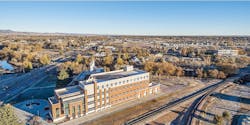Strategies for Success with Radiant Heating and Cooling
Careful integration is the key to making radiant heating and cooling work for your facility, according to a recent case study review by the Center for the Built Environment at the University of California, Berkeley.
Radiant systems are found in 42% of verified net zero energy buildings and when operated correctly, they generally deliver high performance in both energy efficiency and occupant satisfaction. The nine projects profiled in the report yielded several observations about how to ensure success with a radiant heating and/or cooling project, including:
View the building and systems holistically. This applies not only to HVAC, but to the building as a whole. For example, Colorado State University’s Powerhouse Energy Campus, a 65,000-square-foot decommissioned power plant converted into a research and educational building, couples radiant systems with a high-performance envelope and underfloor air distribution. Solid-state lighting and active daylight harvesting reduce the lighting-related energy demand, which in turn helps reduce cooling loads.
Colorado State’s radiant system is actually designed to function without a chiller and instead relies on a cooling tower that provides evaporatively cooled water to the radiant system. A suite of advanced controls forecasts the weather to predict heating and cooling needs and adjust setpoints accordingly.
Consider supplemental ventilation. Several of the profiled projects paired radiant systems with a 100% dedicated outdoor air system (DOAS) for ventilation rather than the majority recycled ventilation air of a conventional VAV system. The radiant panels and DOAS work together by “decoupling the space sensible load and utilizing the DOAS ventilation approach to address the outside air latent load,” the researchers explain. Heat recovery technology in the DOAS can recover heat from sources like electrical room exhaust and other building relief systems. At the Edith Green-Wendell Wyatt Federal Building in Portland, OR, one of the profiled buildings, a heat recovery chiller is added to the setup to cool the on-site data center and supply heat to the radiant heating panels during colder months.
Seek feedback. Occupant thermal comfort surveys are crucial to understanding whether your radiant systems are operating the way they should. One surprising result at a retrofitted Oregon Department of Transportation office saw 39% of occupants reporting that they were satisfied and 41% reporting that they were dissatisfied. However, the facilities team at that building also received the fewest hot and cold calls from occupants compared to other ODOT facilities. Radiant systems are slow to respond to changes in temperature, which can be a tough adjustment for people who are used to the relatively instant response of traditional forced-air systems.
